Submitted:
17 June 2024
Posted:
17 June 2024
You are already at the latest version
Abstract

Keywords:
1. Introduction
2. Results
2.1. Distribution of Wild Umbellifers, Traditionally Used as Food
2.2. Statistical Analyses of the Distribution of Wild Umbellifers, Traditionally Used as Food
2.2.1. Jaccard Index
2.2.1. Heatmap Clustering
3. Discussion
4. Materials and Methods
4.1. Distribution of Wild Umbellifers, Traditionally Used as Food
4.2. Data Set Preparation and Analyses
4.2.1. Jaccard Similarity Coefficient or Jaccard Index JI
4.2.1. Heatmap Clustering
5. Conclusions
Author Contributions
Funding
Institutional Review Board Statement
Data Availability Statement
Acknowledgments
Conflicts of Interest
References
- Mundy, J. H. Europe in the High Middle Ages: 1150-1300. 3rd ed.; Routledge. Taylor and Fransis Group, London and NY, 2014; 1-432.
- Vryonis, S. Religious Change and Continuity in the Balkans and Anatolia from the Fourteenth through the Sixteenth Century. In Islam and cultural change in the Middle Ages. Ed. 1975. Vryonis, S. Ed.; Wiesbaden, H; 1975, Volume 4, pp. 127–141.
- Bresc, H. Medieval and modern Sicily and the kingdoms of Sardinia and Corsica. In A Companion to Sardinian History, 500–1500; Leyde, Brill. 2017; pp. 141–164. [CrossRef]
- Stenner, D. Mediterranean crossroads: Spanish-Moroccan relations in past and present. J North Afric. Stud. 2019 24, 7–16. [CrossRef]
- Torija-Isasa, M.; Matallana-González, M. A Historical Perspective of Wild Plant Foods in the Mediterranean Area. In Mediterranean Wild Edible Plants; Sánchez-Mata, M., Tardío, J., Eds.; Publisher: Springer, New York, NY, 2016; pp. 3–13. [Google Scholar] [CrossRef]
- Lewington, A. Plants for people. Penguin Random House. Transworld Publishers, London, 2003, pp.1-304.
- Dogan, Y. Traditionally used wild edible greens in the Aegean Region of Turkey. Acta Soc. Bot. Pol. 2012, 81, 329–342. [Google Scholar] [CrossRef]
- Molina, M.; Pardo-de-Santayana, M.; Tardío, J. Natural production and cultivation of Mediterranean wild edibles. In Mediterranean wild edible plants: Ethnobotany and food composition tables, de Cortes Sanchez-Mata, M., Javier Tardio, J., EdS.; Publisher: Springer, 2016. [Google Scholar]
- Sánchez-Mata, D.; Morales, R. The Mediterranean landscape and wild edible plants. In Mediterranean wild edible plants: Ethnobotany and Food Composition Tables; Sánchez-Mata, M., Tardío, J. Eds; Springer, New York, NY. 2016, pp.15-31. [CrossRef]
- Ceccanti, C.; Landi, M.; Benvenuti, S.; Pardossi, A.; Guidi, L. Mediterranean wild edible plants: Weeds or “new functional crops”? Molecules 2018, 23, 2299. [Google Scholar] [CrossRef] [PubMed]
- Benítez, G.; Molero-Mesa, J.; González-Tejero, M.R. Wild Edible Plants of Andalusia: Traditional Uses and Potential of Eating Wild in a Highly Diverse Region. Plants 2023, 12, 1218. [Google Scholar] [CrossRef] [PubMed]
- Sayed-Ahmad, B.; Talou, T.; Saad, Z.; Hijazi, A.; Merah, O. The Apiaceae: Ethnomedicinal family as source for industrial uses. Ind. Crop. Prod. 2017, 109, 661–671. [Google Scholar] [CrossRef]
- Gangwar, H.; Kumari, P.; Jaiswal, V. Phytochemically Rich Medicinally Important Plant Families. In Phytochemical Genomics: Plant Metabolomics and Medicinal Plant Genomics; Singapore: Springer Nature Singapore, 2023; pp. 35–68. [Google Scholar]
- Hand, R. (2011). Apiaceae. In Euro+Med-Plantbase – The information resource for Euro-Mediterranean plant diversity. www2bgbm.org/EuroPlusMed/TaxonDetail.asp¿NameCache=Apiaceae&PTRefFk=7500000. – Published at (accessed 10 February 2024).
- Nassif, F.; Tanji, A. Gathered food plants in Morocco: The long-forgotten species in ethnobotanical research. Life Sci. Leafl. 2013, 3, 17–54. [Google Scholar]
- Tanji, A.; Nassif, F. Edible weeds in Morocco. Weed Technology. 1995, 9, 617–620. [Google Scholar] [CrossRef]
- Fennane, M.; Ibn Tattou, M.; El Oualidi, J. Flore Pratique du Maroc. In Pteridophyta, Gymnospermae, Angiospermae (Lauraceae-Neuradaceae): Manuel de Détermination, Trav. l’Institut Sci. Série Bot; Volume 1, 1999.
- Fennane, M.; Ibn Tattou, M. Statistiques et commentaires sur l’inventaire actuel de la flore vasculaire du Maroc. Flora 2008, 1986, 1989. [Google Scholar]
- Fennane, M. Ibn Tattou, and J. El Oualidi. Flore pratique du Maroc, Dicotylédones (pp), Monocotylédones. In Travaux de l’Institut Scientifique Rabat, Série Botanique 40, Volume 3, 2014.
- Belahsen, R.; Tanji, A. Gathered food plants in Morocco: The long forgotten species in ethnobotanical research. Life Sci. Leafl. 2013, 3, 17–54. [Google Scholar]
- Tbatou, M.; Belahyan, A.; Belahsen, R. Wild edible plants traditionally used in the countryside of El Jadida, coastal area in the Center of Morocco. Life Sci. Leafl. 2016, 75, 28–48. [Google Scholar]
- Tbatou, M.; Fagroud, M.; Belahyan, A.; Belahsen, R. Wild edible plants traditionally used in the rural area of El Jadida (Center of Morocco): Assessing traditional knowledge erosion. Life Sci. Leafl. 2016, 78, 30–51. [Google Scholar]
- Tardío, J.; Pascual, H.; Morales, R. Wild food plants traditionally used in the province of Madrid, Central Spain. Econ. Bot. 2005, 59, 122–136. [Google Scholar] [CrossRef]
- Tardío, J.; Pardo de Santayana, M.; Morales, R. Ethnobotanical review of wild edible plants in Spain. Bot. J. Linn. Soc. 2006, 152, 27–72. [Google Scholar] [CrossRef]
- Morales, R.; Tardío, J.; Aceituno, L.; Molina, M.; Pardo de Santayana, M. Biodiversidad y Etnobotánica en España. In Memorias Real Sociedad, Española de Historia Natural, Madrid, Spain, 2011; pp. 157–208.
- Raimondo, F.M.; Lentini, F. Indagini entnobotaniche in Sicilia. I. Le piante della flora locale nella tradizione popolare delle Madonie (Palermo). Naturalista Siciliano, s. 1990, 4, 14–3. [Google Scholar]
- Giardina, G.; Raimondo, F.M.; Spadaro, V. A catologue of the plants growing in Sicily. Bocconea 2007, 20, 5–582. [Google Scholar]
- Schicchi, R.; Geraci, A. Verdure Spontanee per L’alimentazione e la Salute; Palermo University Press: Palermo, Italy, 2021. [Google Scholar]
- Mazzola, P. Le piante selvatiche nella tradizione alimentare dei Monti Nebrodi (Sicilia). Università di Palermo e Parco dei Nebrodi. pp. 174, 2020.
- Pieroni, A.; Nebel, S.; Santoro, R.F.; Heinrich, M. Food for two seasons: Culinary uses of non-cultivated local vegetables and mushrooms in a south Italian village. Int. J. Food Sci. Nutr. 2005, 56, 245–72. [Google Scholar] [CrossRef] [PubMed]
- Nebel, S.; Pieroni, A.; Heinrich, M. Ta chòrta: Wild edible greens used in the Graecanic area in Calabria, Southern Italy. Appetite 2006, 47, 333–342. [Google Scholar] [CrossRef] [PubMed]
- Pieroni, A.; Quave, C.L. Functional foods or food medicines? On the consumption of wild plants among Albanians and southern Italians in Lucania. In Eating and Healing Traditional Food as Medicine, Pieroni, A.; Leimer Price, L. Eds., Publisher: Haworth Press 2006, 101-129.
- Mattalia, G.; Quave, C.L.; Pieroni, A. Traditional uses of wild food and medicinal plants among Brigasc, Kyé, and Provençal communities on the Western Italian Alps. Genet. Resour. Crop. Ev. 2013, 60, 587–603. [Google Scholar] [CrossRef]
- Biscotti, N.; Pieroni, A. The hidden Mediterranean diet: Wild vegetables traditionally gathered and consumed in the Gargano area, Apulia, SE Italy. Acta Soc. Bot. Pol. 2015, 84. [Google Scholar] [CrossRef]
- Pieroni, A. Traditional uses of wild food plants, medicinal plants, and domestic remedies in Albanian, Aromanian and Macedonian villages in South-Eastern Albania. J. Herb. Med. 2017, 9, 81–90. [Google Scholar] [CrossRef]
- Pieroni, A.; Sõukand, R.; Quave, C.L.; Hajdari, A.; Mustafa, B. Traditional food uses of wild plants among the Gorani of South Kosovo. Appetite 2017, 108, 83–92. [Google Scholar] [CrossRef] [PubMed]
- Hadjichambis, A.C.; Paraskeva-Hadjichambi, D.; Della, A.; Elena Giusti, M.; De Pasquale, C.; Lenzarini, C.; Censorii, E.; Gonzales-Tejero, M.R.; Sanchez-Rojas, C.P.; Ramiro-Gutierrez, J.M.; Skoula, M.; Johnson, C.; Sarpaki, A.; Hmamouchi, M.; Jorhi, S.; El-Demerdash, M.; El-Zayat, M.; Pieroni, A. Wild and semi-domesticated food plant consumption in seven circum-Mediterranean areas. Int. J. Food Sci. Nutr. 2008, 59, 383–414. [Google Scholar] [CrossRef] [PubMed]
- Pieroni, A.; Cattero, V. Wild vegetables do not lie: Comparative gastronomic ethnobotany and ethnolinguistics on the Greek traces of the Mediterranean Diet of southeastern Italy. Acta Bot. Bras. 2019, 33, 198–211. [Google Scholar] [CrossRef]
- Della, A.; Paraskeva-Hadjichambi, D.; Hadjichambis, A.C. An ethnobotanical survey of wild edible plants of Paphos and Larnaca countryside of Cyprus J. Ethnobiol. Ethnomed. 2006, 2, 34. [Google Scholar] [CrossRef] [PubMed]
- Pieroni, A.; Sulaiman, N.; Polesny, Z.; Sõukand, R. From Şxex to Chorta: The Adaptation of Maronite Foraging Customs to the Greek Ones in Kormakitis, Northern Cyprus. Plants 2022, 11, 2693. [Google Scholar] [CrossRef] [PubMed]
- Dogan, Y.; Baslar, S.; Ay, G.; Mert, H.H. The use of wild edible plants in western and central Anatolia (Turkey). Econ. Bot. 2004, 58, 684–690. [Google Scholar] [CrossRef]
- Dogan, Y.; Nedelcheva, A.; Łuczaj, Ł.; Drăgulescu, C.; Stefkov, G.; Maglajlić, A.; Ferrier, J.; Papp, N.; Hajdari, A.; Mustafa, B.; Dajić-Stevanović, Z.; Pieroni A., A. Of the importance of a leaf: The ethnobotany of sarma in Turkey and the Balkans. J. Ethnobiol. Ethnomed. 2015, 11, 1–15. [Google Scholar] [CrossRef]
- Kaval, İ.; Behçet, L.; Çakilcioğlu, U. Survey of wild food plants for human consumption in Geçitli (Hakkari, Turkey). Indian J. Tradit. Know. 2015, 14, 183–190. [Google Scholar]
- Cakir, E.A. Traditional knowledge of wild edible plants of Igdir Province (East Anatolia, Turkey). Acta Soc. Bot. Pol. 2017, 86. [Google Scholar] [CrossRef]
- Stoyanov, N.; Kitanov, B. Wild useful plants. Bulgarian Academy of Sciences Publ. House, Sofia, 1960; pp. 480.
- Nedelcheva, A. An ethnobotanical study of wild edible plants in Bulgaria. Eurasia. J. Biosci. 2013, 7, 77–94. [Google Scholar] [CrossRef]
- Cheshmedzhiev, I.; Genchev, S.; Dimitrova, D.; Varbanova, K. Wild plants on our table. Zemizdat, Sofia, 1999; pp. 147.
- Ivanova, T.; Chervenkov, M.; Kozuharova, E.; Dimitrova, D. Ethnobotanical knowledge on herbs and spices in Bulgarian traditional dry-cured meat products. Diversity 2022, 14, 416. [Google Scholar] [CrossRef]
- Ivanova, T.; Marchev, A.; Chervenkov, M.; Bosseva, Y.; Georgiev, M.; Kozuharova, E.; Dimitrova, D. Catching the Green—Diversity of Ruderal Spring Plants Traditionally Consumed in Bulgaria and Their Potential Benefit for Human Health. Diversity 2023, 15, 435. [Google Scholar] [CrossRef]
- Grossheim, A.A. Plant resources of the Caucasus. Baku: Publishing house of AS of Azerbaijani SSR; 1946. (in Russian).
- Zolotnitskaya, S. Medicinal resources of the flora of Armenia. vols. 1–2. Yerevan; 1958–1965 (in Russian).
- Gubanov, I.; Krilova, I.; Tikhonova, V. Wild useful plants of the USSR. Moscow; 1976 (in Russian).
- Takhtajan, A. 1954—2001 Flora of Armenia. Vol. 6. Yerevan: Ed. Acad. Sci. Arm. SSR. (In Russian).
- Gabrielyan, E. Herbal medicine national register. Yerevan. 2001 (in Armenian).
- Bussmann, R.W. Ethnobotany of the Caucasus. XXVII; Springer International Publishing; 2017; pp. 746. ISBN 978-3-319-49411-1.
- Fayvush, G. Biodiversity of Armenia. Springer Cham; 2023; pp. 440. ISBN: 9783031343315.
- Sulaiman, N.; Pieroni, A.; Sõukand, R.; Polesny, Z. Food Behavior in Emergency Time: Wild Plant Use for Human Nutrition during the Conflict in Syria. Foods 2022, 11, 177. [Google Scholar] [CrossRef] [PubMed]
- Tukan, S.K.; Takruri, H.R.; Al-Eisawi, D.M. The use of wild edible plants in the Jordanian diet. Int. J. Food Sci. Nutr. 1998, 49, 225–235. [Google Scholar] [CrossRef] [PubMed]
- Tukan, S.K.; Takruri, H.R.; Ahmed, M.N. Food habits and traditional food consumption in the Northern Badia of Jordan. J. Saud. Soc. Food Nutr. 2011, 6, 1–20. [Google Scholar]
- Takruri, H.R.; Tukan, S.K.; Ahmad, M.N. Medicinal and edible wild plants used by the community of Northern Badia of Jordan. Jordan J. Agric. Sci. 2008, 4, 391–405. [Google Scholar]
- Ali-Shtayeh, M.S.; Jamous, R.M.; Al-Shafie, J.H.; Elgharabah, W.A.; Kherfan, F.A.; Qarariah, K.H.; Khdair, I.S.; Soos, I.M.; Musleh, A.A.; Isa, B.A.; Herzallah, H.M.; Khlaif, R.B.; Aiash, S.M.; Swaiti, G.M.; Abuzahra, M.A.; Haj-Ali, M.M.; Saifi, N.A.; Azem, H.K.; Nasrallah, H.A. Traditional knowledge of wild edible plants used in Palestine (Northern West Bank): A comparative study. J. Ethnobiol. Ethnomed. 2008, 4, 1–13. [Google Scholar] [CrossRef] [PubMed]
- Siviero, P.; Esposito, C.; De Masi, L. Il finocchio (Foeniculum vulgare var. dulce Mill.). Ess. Deriv. Agr. 2005, 75, 15–20. [Google Scholar]
- Mutlucan, M.; Erbaş, S.; Erdoğan, Ü. Fennel (Foeniculum vulgare) agriculture, problems and future in the world and in Turkey. In ISPEC 11th International conference on agriculture, animal sciences and rural development 3-5 March 2023 Muş-Turkiye.
- Norman, J. Herbs & Spices. DK Penguin Random House, UK; 2015, pp. 186.
- Peev, D.; Petrova, A.S.; Anchev, M.; Temniskova, D.; Denchev, C.M.; Ganeva, A.; Gussev, Ch.; Vladimirov, V. Red Data Book of the Republic of Bulgaria. Vol. 1. Plants and Fungi. Publisher: BAS & MoEW, Sofia, 2015; pp. 887. ISBN 978-954-9746-21-1.
- Kislev, M.E.; Hartman, A.; Galili, E. Archaeobotanical and archaeoentomological evidence from a well at Atlit Yam indicates colder, more humid climate on the Israeli coast during the PPNS period. J. Archaeol. Sci. 2004, 32, 1301–1310. [Google Scholar] [CrossRef]
- Nawash, O.; Shudiefat, M.; Al-Tabini, R.; Al-Khalidi, K. Ethnobotanical study of medicinal plants commonly used by local bedouins in the badia region of Jordan. J. Ethnopharmacol. 2013, 148, 921–925. [Google Scholar] [CrossRef]
- Levey, M. Research sources in Ancient Mesopotamian chemistry. Ambix 1958, 6, 149–154. [Google Scholar] [CrossRef]
- Oberlin, L. Meaning, Exchange, and Wine Economics: An Investigation into the Minoan Trickle Pattern Motif’s Presence and Use from the Early Minoan I-Late Minoan III Doctoral dissertation, <bold>2018</bold>, The University of Arizona.
- Koerper, H.; Kolls, A.L. The silphium motif adorning ancient Libyan coinage: Marketing a medicinal plant. Econ. Bot. 1999, 133–143. [Google Scholar] [CrossRef]
- Mosca, A. Natural Environmental Factors and Human Settlement in Western Sicily. The Example of Lilybaeum. 2018, In The Ancient City and Nature’s Economy in Magna Graecia and Sicily, Panel 2.1, Archaeology and Economy in the Ancient World 3, Bergemann, J., Rempe M. Eds., Heidelberg, Propylaeum; 2022; 79–92. [CrossRef]
- https://www.youtube.com/watch?v=UY9P0QSxlnI.
- Page, M.J.; McKenzie, J.E.; Bossuyt, P.M.; Boutron, I.; Hoffmann, T.C.; Mulrow, C.D.; Shamseer, L.; Tetzlaff, J.M.; Akl, E.A.; Brennan, S.E.; Chou, R.; Glanville, J.; Grimshaw, J.M.; Hróbjartsson, A.; Lalu, M.M.; Li, T.; Loder, E.W.; Mayo-Wilson, E.; McDonald, S.; McGuinness, L.A.; Stewart, L.A.; Thomas, J.; Tricco, A.C.; Welch, V.A.; Whiting, P.; Moher, D. The PRISMA 2020 statement: An updated guideline for reporting systematic reviews. BMJ. 2021, 88, 105906. [Google Scholar] [CrossRef] [PubMed]
- Real, R. , Vargas, J. M. The probabilistic basis of Jaccard’s index of similarity. Syst. Biol. 1996, 45, 380–385. [Google Scholar] [CrossRef]
- NCSS 2024 Statistical Software (2024). NCSS, LLC. Kaysville, Utah, USA, ncss.com/software/ncss (Accessed 10 April 2024).
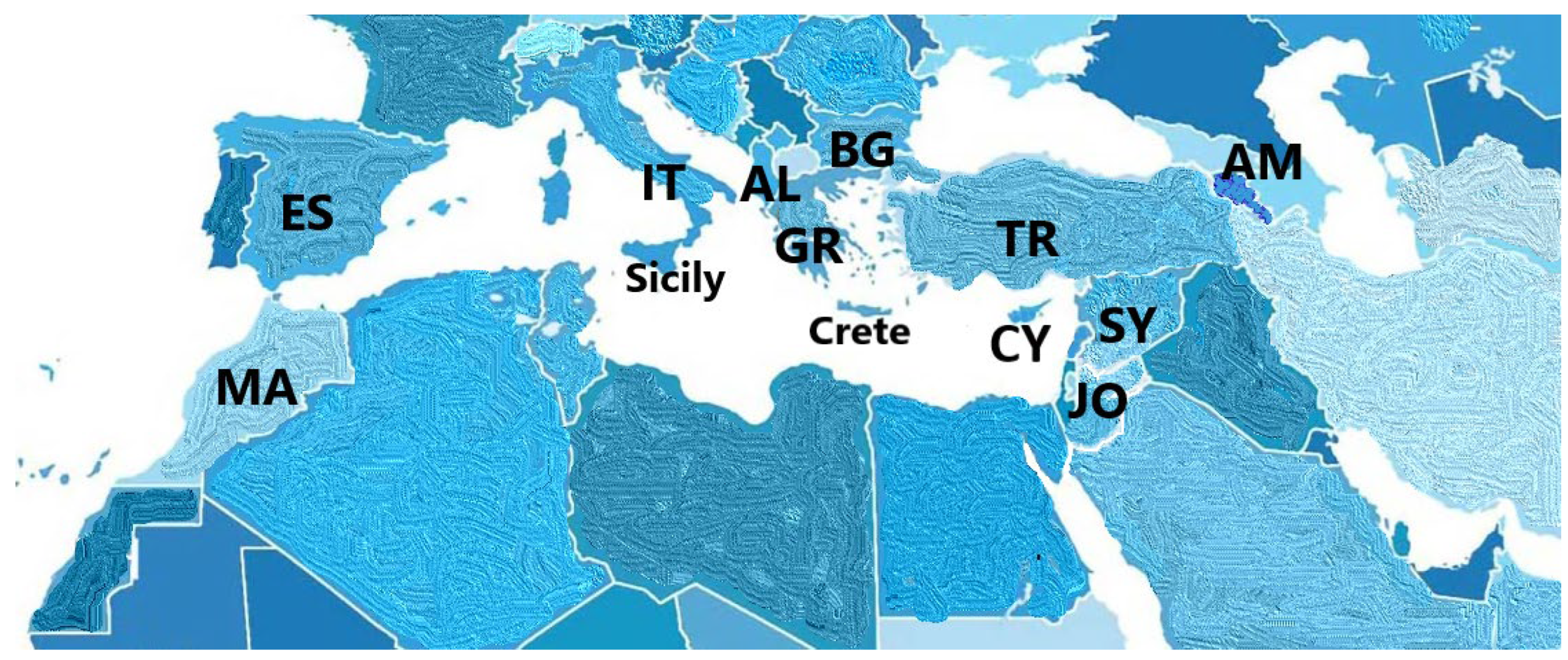
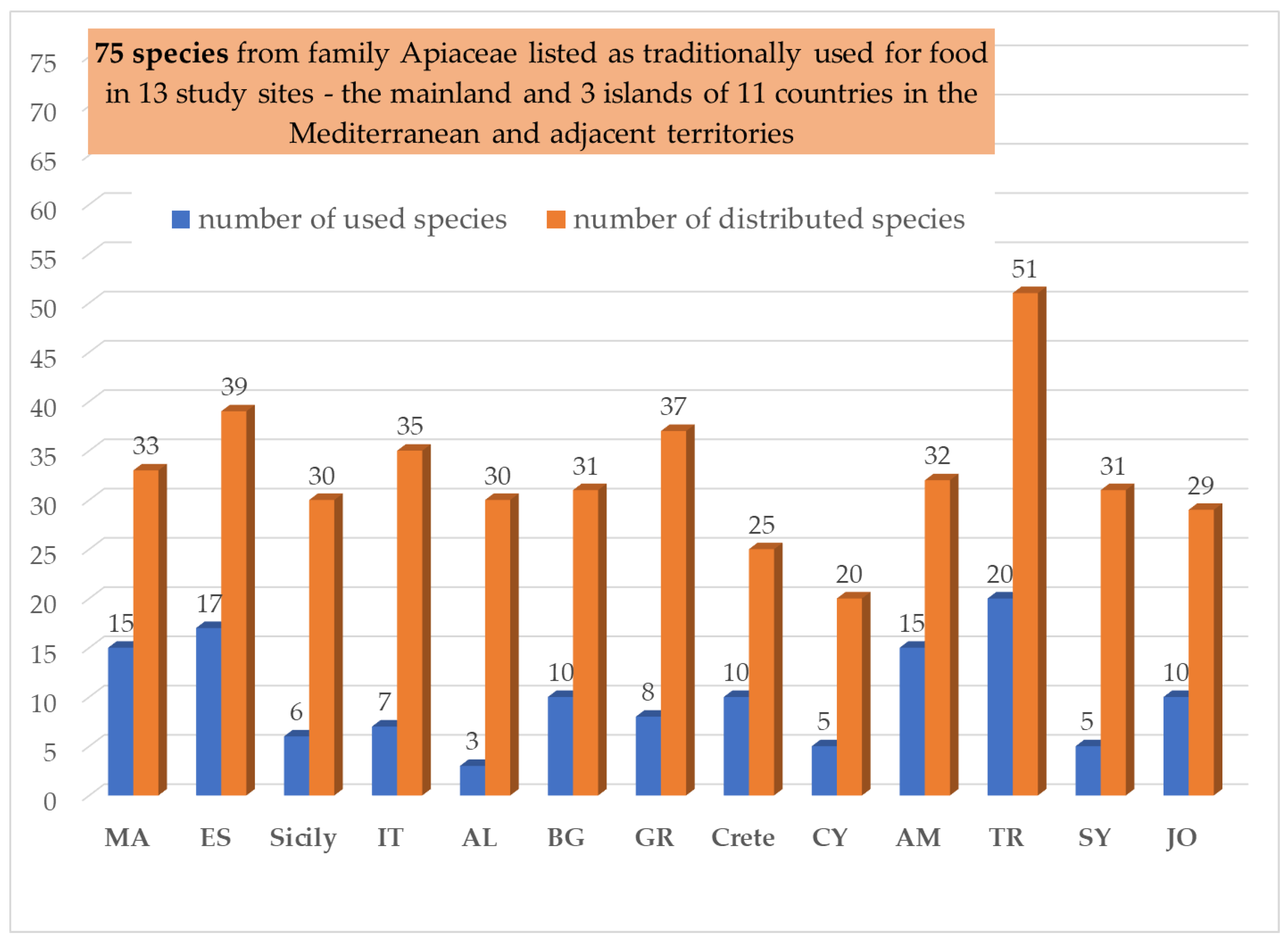
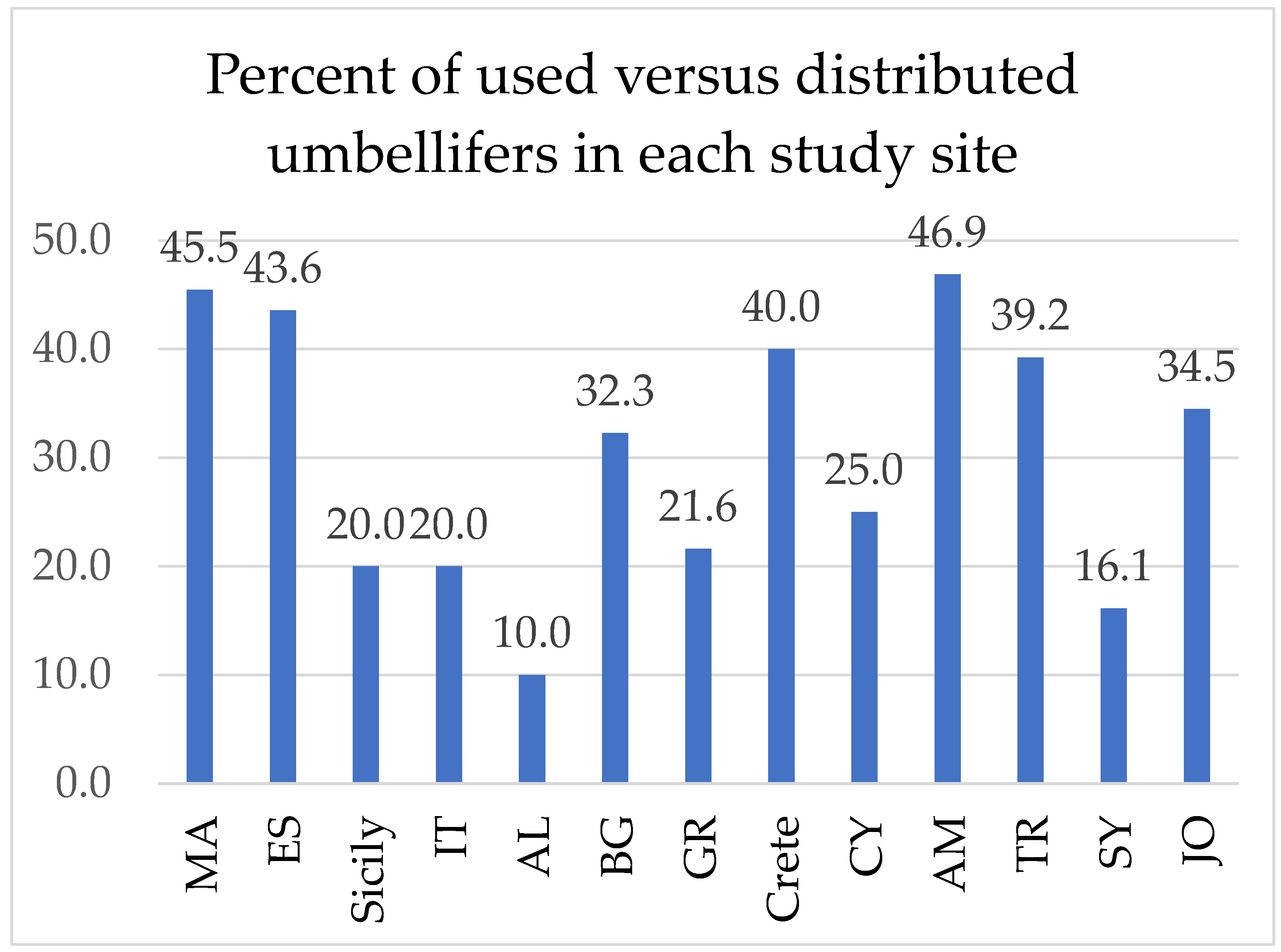
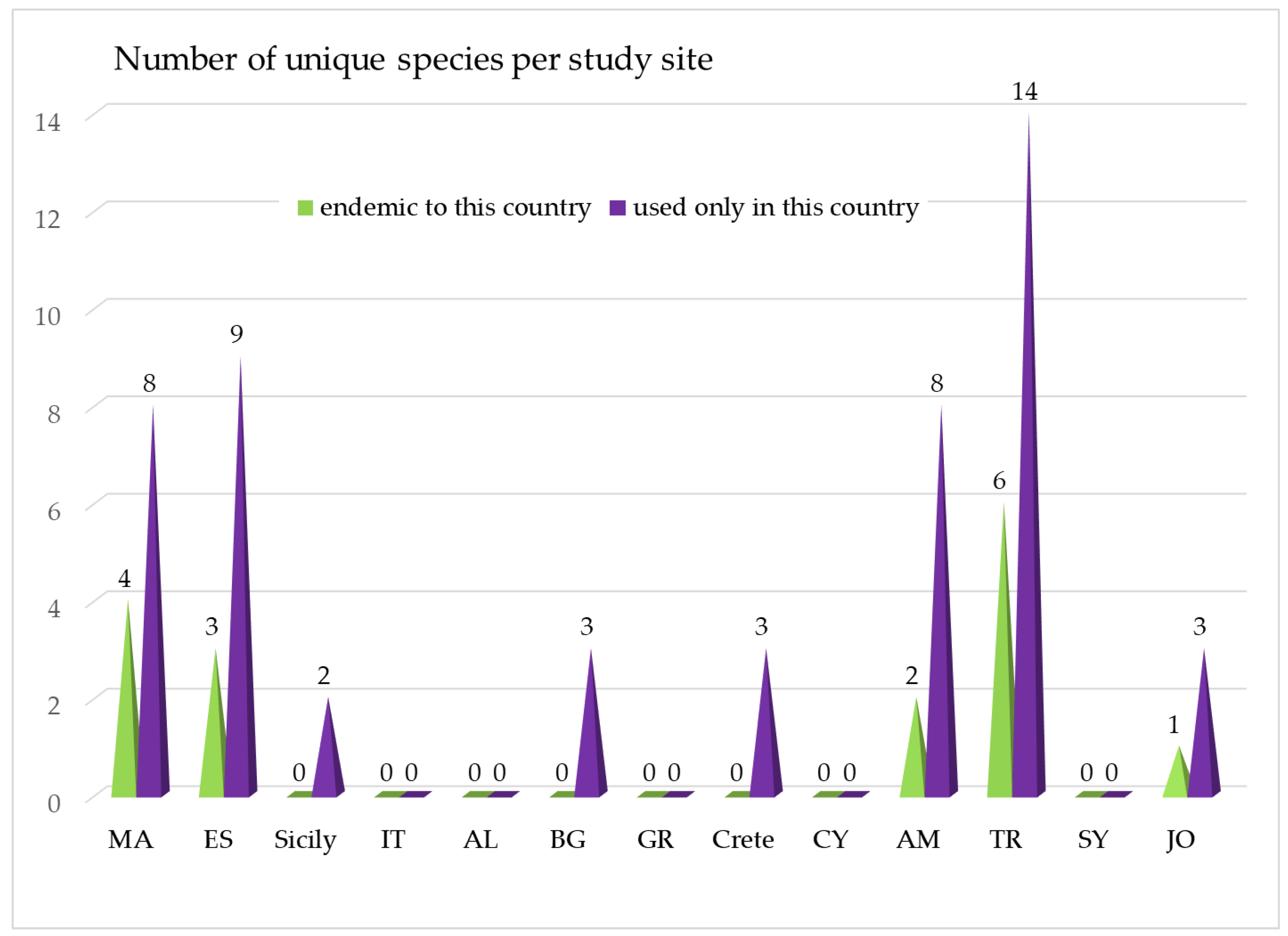
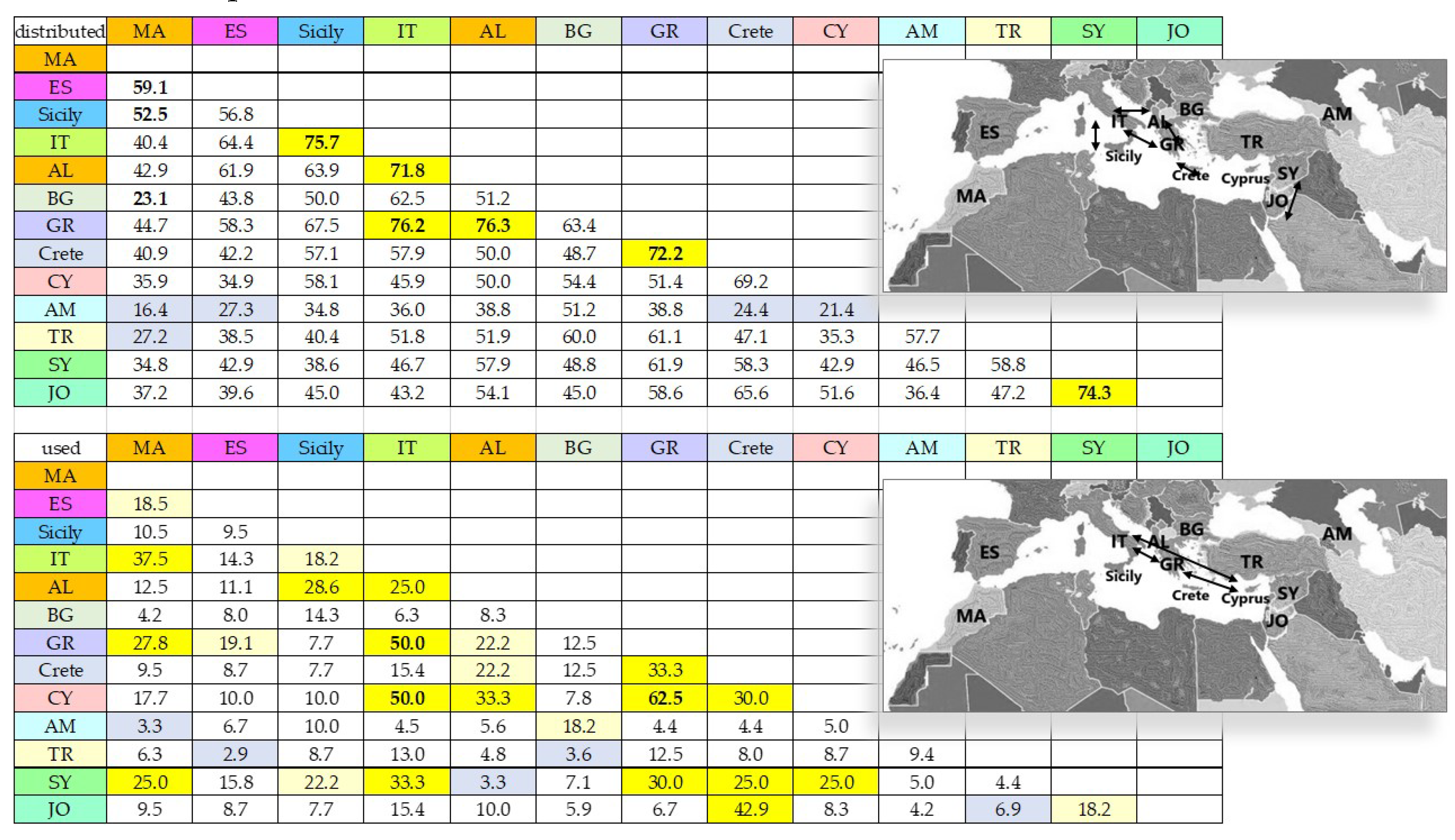
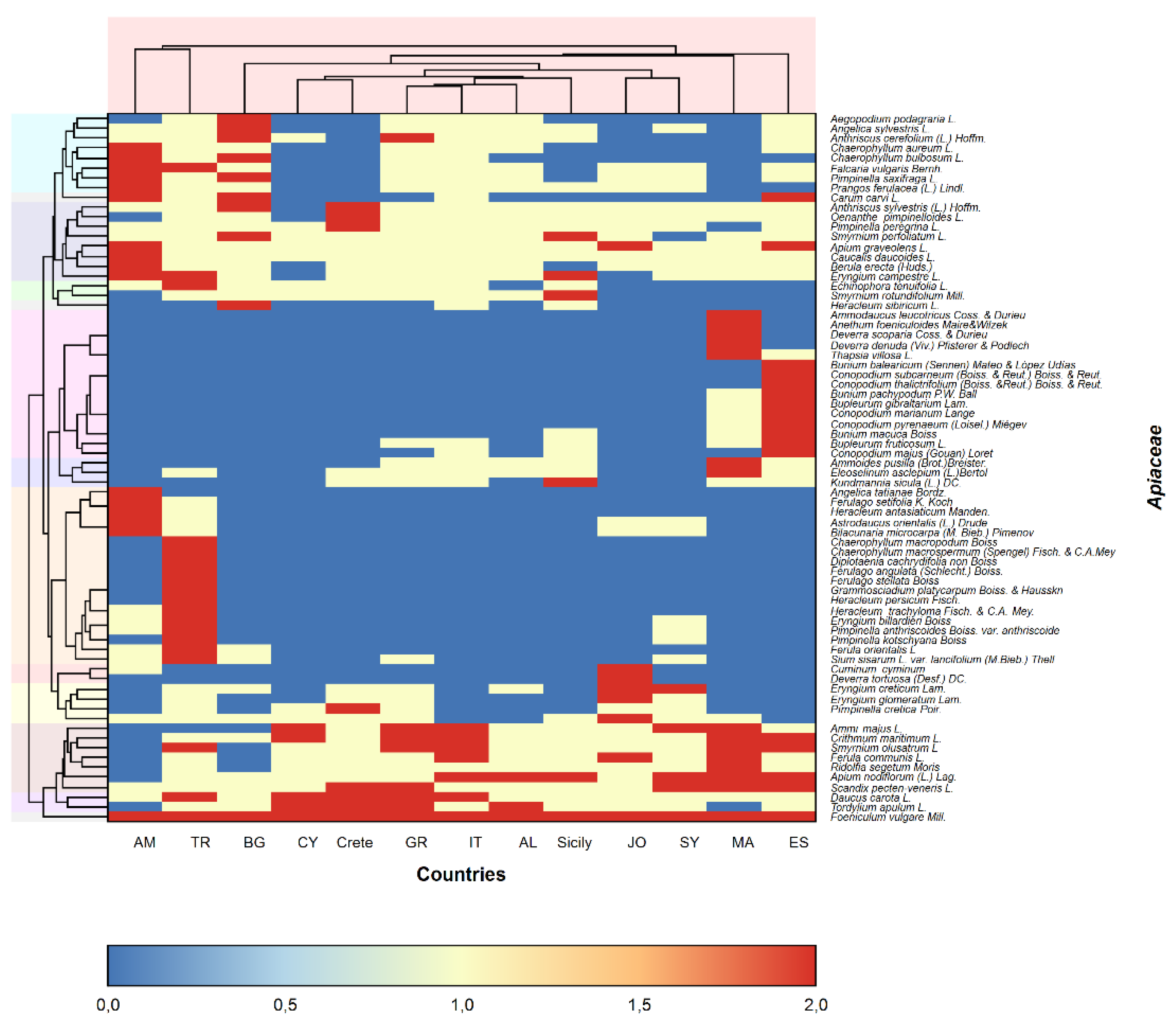
| Taxon | Presence in countries of the study area | Used as food | Used part and modes of application |
| Aegopodium podagraria L. | AL, BG, ES, GR, IT, TR | BG | Sprouts, salad raw, soup, |
| Ammi majus L. | AL, Crete, CY, GR, ES, IT, JO, MA, Sicily, SY, | SY | Inflorescence, added to yerba mate |
| CY | Aerial parts, salads | ||
| GR | Aerial parts, sauté | ||
| IT | Aerial parts boiled then on pasta, dressing with “pecorino” cheese and olive oil | ||
| MA | Stems | ||
| Ammodaucus leucotricus Coss. & Durieu | MA | MA | Seeds |
| Ammoides pusilla (Brot.) Breister. | AL, ES, GR, IT, MA, Sicily | MA | Aereal parts |
| Anethum foeniculoides Maire & Wilzek | MA | MA | Aerial parts, seeds |
| Anethum graveolens L. | native AL, BG, CY, ES, MA, TR, introduced to AM, Crete, GR, JO, SY; naturalized in IT, casual to Silicy,; |
TR | Aboveground, salad, seasoning, raw, plant is with yogurt |
| JO |
Seed Consumed cultivated in BG, as the plant is listed as Endangered in the Red Data Book |
||
| Angelica sylvestris L. | AL, AM, BG, ES, GR, IT, Sicily, SY, TR | BG | Sprouts, leaves, salad raw, soup, |
| Angelica tatianae Bordz. | AM | AM | Petiole, stem |
| Anthriscus cerefolium (L.) Hoffm. | native AM, AL, BG, CY, GR, Sicily, TR introduced to MA, IT, naturalised to ES |
BG | Leaves, shoots, salad raw, soup, spice |
| GR | Young aerial parts, boiled | ||
|
Anthriscus sylvestris (L.) Hoffm. |
AL, AM, BG, ES, GR, IT, JO, MA, Sicily, SY TR | AM | Stems, leaves |
| BG | Roots, leaves, shoots, salad raw, soup, pastry | ||
| Crete | Young aerial parts, fried in mixtures as a filling for pies | ||
| Apium graveolens L. | native AL, AM, BG, Crete, CY, ES, GR, IT, JO, MA, Sicily, SY, TR | JO | Petiole, leaves |
| AM | Leaves, roots | ||
| *ES | Leaves, raw in salads or stewed | ||
| Astrodaucus orientalis (L.) Drude | AM, JO, SY, TR | AM | Stems |
| Berula erecta (Huds.) Coville | AL, AM, BG, Crete, ES, GR, IT, JO, MA, SY, TR | AM | Leaves, fruits |
| Bunium balearicum (Sennen) Mateo & López Udías | ES | *ES | Tubers, raw as a snack |
| Bunium macuca Boiss. | ES, MA, Sicily |
ES | Tubers, raw as a snack (they taste chestnut) |
| Bunium pachypodum P.W. Ball | ES, MA | *ES | Tubers, raw as a snack |
| Bupleurum fruticosum L. | ES, GR, IT, MA, Sicily | *ES | Aerial parts, for hardening olives |
| Bupleurum gibraltaricum Lam. | ES, MA | *ES | Aerial parts for hardening olives |
| Cachrys microcarpa M. Bieb. (syn. ** Bilacunaria microcarpa (M. Bieb.) Pimenov & V.N. Tikhom. | AM, JO, SY, TR | AM | Stems, leaves |
|
Carum carvi L. |
AL, AM, BG, ES, IT, TR | AM | Stems, leaves, seeds |
| BG | Fruits, spice | ||
| *ES | Fruits | ||
| Centella asiatica (L.) Urb. | native in Georgia and tropical and subtropical Asia and Africa | JO | Above ground organs |
| Chaerophyllum aureum L. | AL, AM, BG, ES, GR, IT, TR | AM | Stems, leaves |
| Chaerophyllum bulbosum L. | AM, BG, GR, IT, TR | AM | Stems, leaves, roots |
| BG | Young shoots, corms, salad raw and stew | ||
| Chaerophyllum macropodum Boiss. | TR | TR | Eaten fresh |
| Chaerophyllum macrospermum (Spengel) Fisch. & C. A. Mey. | AM, TR | TR | Cooked as a stew or egg-vegetable dish; used in cheese production |
| Conopodium majus (Gouan) Loret | ES, IT, Sicily | ES | Tubers, raw as a snack (they taste chestnut) |
| Conopodium marianum Lange | ES, MA | ES | Tubers, raw as a snack |
| Conopodium pyrenaeun (Loisel.) Miégev | ES, MA | ES | Tubers, raw as a snack |
| Conopodium subcarneum (Boiss. & Reut.) Boiss. & Reut. | ES | *ES | Tubers, raw as a snack |
| Conopodium thalictrifolium (Boiss.) Calest. | ES | *ES | Tubers, raw as a snack |
| Coriandrum sativum L. | native to JO, SY, naturalized to IT, MA, casual to ES, Sicily; introduced to AL, AM, BG, GR, Crete, CY, TR |
AM | Stems, fruits |
| TR | Cooked as a stew or rice-vegetable dish; pie is made from its seeds | ||
| Crithmum maritimum L. | BG, Crete, CY, ES, GR, IT, JO, MA, Sicily, SY, TR | IT | Young leaves, shoots boiled and dressed with vinegar (or lemon juice) and olive oil |
| MA | Aerial parts | ||
| *ES | Leaves, for seasoning olives; raw in salads; roots, raw as a snack | ||
| CY | Young aerial parts, boiled, then pickled | ||
| GR | Young aerial parts, boiled, then pickled | ||
| Cuminum cyminum L. | AM, ES, JO, casual to Sicily and MA | JO | Seed |
| Daucus carota L. | AL, AM, BG, Crete,CY, ES, GR, IT, JO, MA, Sicily, SY, TR | CY | Young aerial parts, boiled |
| GR | Young aerial parts, boiled | ||
| IT | Root, roasted, boiled, fried | ||
| TR | Shoot and leaf meal, pancake, stew | ||
| Crete | Young aerial parts, boiled in mixtures | ||
| Daucus carota L. subsp. maximus (Desf.) Ball | AL, BG, Crete, CY, ES, GR, IT, JO, MA, Sicily, SY, TR | JO | Fleshy roots, eaten raw |
| *ES | Roots, as a snack, young leaves stewed | ||
| Daucus carota L. subsp. carota | AL, BG, Crete, CY, ES, GR, IT, MA, Sicily, TR | Sicily | Tender basal leaves and roots, raw in salads or stewed. |
| Deverra scoparia Coss. & Durieu | MA | MA | Shoots, core of roots, aerial parts |
| Devera denudata (Viv.) Pfisterer & Podlech | MA | MA | Shoots, core of roots |
| Deverra tortuosa (Desf.) DC. | JO | JO | Leaf and flower |
| Diplotaenia turcica Pimenov & Kljuykov (syn. **Diplotaenia cachrydifolia sensu P. H. Davis, non Boiss) | TR | TR | Cooked as a stew or egg-vegetable dish; used in brine and cheese production |
| Echinophora tenuifolia L. | AM, BG, Crete, CY, GR, IT, Sicily, TR |
TR | Shoot, flower, leaf soup, seasoning, drinking |
| Eleoselinum asclepium (L.) Bertol. | AL, Crete, GR, ES, IT, MA, Sicily, TR | MA | Aereal parts |
| Eryngium billardieri F. Delaroche. | TR, AM, SY | TR | Eaten fresh |
| Eryngium campestre L. | AL, AM, BG, Crete, ES, GR, IT, MA, Sicily, SY, TR | AM | Leaves, roots |
| Sicily | Sprouts, raw in salads. | ||
| TR | Shoot and leaf pie, stew | ||
| Eryngium creticum Lam. | AL, BG, Crete, CY, GR, JO, SY, TR, casual to IT |
JO | Vegetables leaves and stems, eaten raw as salad with garlic and yoghurt, or cooked as pastry |
| SY | Young aerial part, salad; steamed. | ||
| Crete, | Young aerial part, salad | ||
| Eryngium glomeratum Lam. | Crete, GR, JO, SY, TR | JO | Young aerial part, salad |
| Crete, | Young aerial part, salad | ||
| Falcaria vulgaris Bernh. | AL, AM, BG, ES, GR, IT, JO, SY TR, | TR | Aerial parts cooked as vegetable; leaves eaten in salads |
| AM | Stems | ||
| Ferula assa-foetida L. | native to Libya |
JO | Root |
| Ferula communis L. | AL, Crete, CY, ES, GR, IT, JO, MA, Sicily, SY, TR | IT | Inflorescences deep fried |
| MA | Unopen inflorescence | ||
| JO | Vegetables inflorescence, eaten cooked | ||
| Ferula orientalis L. | AM, BG, TR | TR | Cooked plant is with yogurt; used in brine and cheese production |
| Ferulago angulata (Schlecht.) Boiss. subsp. angulata | TR | TR | Used in cheese production |
| Ferulago angulata (Schlecht.) Boiss. subsp. carduchorum (Boiss. & Hausskn.) Chamberlain | TR | TR | Used in cheese production |
| Ferulago setifolia K. Koch | AM, TR | AM | Leaves, stems |
| Ferulago stellata Boiss. | TR | TR | Cooked as a stew or egg-vegetable dish; used in brine and cheese production |
|
Foeniculum vulgare Mill. |
AL,AM, BG, Crete, CY, ES, GR, IT, JO, MA, Sicily, SY TR |
AM | Stems, fruits |
| BG | Leaves, mericarps, spice | ||
| CY | Leaves and tender stems, raw as a snack or in salads, or stewed and cooked, seasoning (especially snails) | ||
| ES | Leaves and tender stems, raw as a snack or in salads, or stewed | ||
| GR | Leaves and tender stems, raw as a snack or in salads, or stewed, fried,saute | ||
| MA | Tender stems, tender leaves,roots after being peeled, seeds | ||
| TR | Aboveground meal, roasted, pilaf, as spice | ||
| JO | Seeds, as herbal tea seeds, boiled and added to bread leaves, dried and added to pickles, fruits foliage, eaten raw foliage, dried and added to cake as a condiment, foliage, eaten raw as salad, or cooked as soup | ||
| Sicily | Leaves and tender shoots, raw as a snack or in salads, or stewed; seeds as a condiment and for the herbal teas and digestive liquors preparation. | ||
| Crete | Leaves, fried in mixtures as a filling for pies or seasoning stewed potatoes and tomatoes | ||
| SY | Aerial part, spice added to zaatar and soups; fried with: eggs/ meat/potato | ||
|
Foeniculum vulgare subsp. piperitum (C. Presl.) Bég. |
AL | Young aerial parts and fruits boiled, then on pasta or in mixed vegetablesyoung leaves, shoots boiled and dressed with vinegar (or lemon juice) and olive oil | |
| IT | Young aerial parts and fruits boiled, then on pasta or in mixed vegetablesyoung leaves, shoots boiled and dressed with vinegar (or lemon juice) and olive oil | ||
| Grammosciadium platycarpum Boiss. & Hausskn. | TR, AL | TR | Eaten fresh |
| Heliosciadium nodiflorum (L.) W.D.J. Koch (**syn. Apium nodiflorum (L.) Lag.) | AL, BG, Crete, CY, ES, GR, IT, JO, MA, Sicily, SY, TR | AL | Aerial parts raw in salads; seasoning soups |
| IT | Aerial parts raw in salads; seasoning soups | ||
| ES | Tender leaves and stems, raw in salads. | ||
| Sicily | Tender leaves and stems, raw in salads or stewed. | ||
| SY | Young aerial part, appetizer | ||
| MA | Aerial parts | ||
| Heracleum antasiaticum Manden. | AM, TR | AM | Stems |
| Heracleum persicum Fisch. | TR | TR | Used in cheese production |
| Heracleum sibiricum L. | BG, IT, Sicily | BG | Leaves, shoots, salad raw, soup, spice |
| Heracleum trachyloma Fisch. & C.A. Mey. | TR, AM | TR | Leaves stffed, stems as spice, eaten raw afer bark is peeled |
| Kundmannia sicula (L.) DC. | Crete, ES, GR, IT, MA, Sicily, | Sicily | Basal leaves, stewed. |
| Levisticum officinale W. D. J. Koch | native to JO; introduced to BG, ES; casual to AL. naturalized in IT |
JO | Leaves |
| Oenanthe pimpinelloides L. | AL, BG, Crete, ES, GR, IT, JO, MA, Sicily, SY, TR | Crete | Young aerial parts, fried in mixtures in pies |
| Orlaya daucoides (L.) Greuter (syn. **Caucalis daucoides L.) | AL, AM, BG, Crete, CY, ES, GR, IT, JO, MA, Sicily, SY, TR | AM | Stems |
| Pastinaca sativa L. | AL, AM, BG, ES, GR, IT, Sicily, TR | JO | Leaves, root |
| Petroselinum crispum (Mill.) Fuss | native to JO, MA casual to Sicily; doubtfully native to AL, introduced to AM, BG, GR, Crete, CY, TR; naturalized to ES |
JO | Petiole, root, stem, leaves |
| Pimpinella kotschyana Boiss. | SY, TR, | TR | Used in rennet production |
| Pimpinella saxifraga L. | AL, AM, BG, GR, ES, IT, JO, SY, TR | AM | Seeds |
| BG | Root, leaves, fruits, salad raw, spice | ||
| Pimpinella cretica Poir. | Crete, CY, GR, JO, SY, TR | Crete | Young aerial parts, in mixtures for pies |
| Pimpinella peregrina L. | AL, AM, BG, Crete, CY, GR, IT, JO, Sicily, SY, TR | Crete | Young aerial parts, in mixtures for pies |
| Prangos ferulacea (L.) Lindl. | AL, AM, BG, GR, IT, JO, Sicily, SY, TR, | AM | Leaves |
| Pseudopimpinella anthriscoides (Boiss.) F. Ghahrem. & al. (syn. **Pimpinella anthriscoides Boiss.) | AM, SY, TR | TR | As spice; cooked as a stew or egg vegetable dish |
| Ridolfia segetum (Guss.) Moris | AL, Crete, CY, ES, GR, IT, JO, MA, Sicily, SY, TR | MA | Stems |
| Scandix pecten-veneris L. | AL, AM, BG, Crete, CY, ES, GR, IT, JO, MA, Sicily, SY, TR |
*ES | Young basal leaves, stewed |
| MA | Basal leaves | ||
| GR | Young leaves, soups | ||
| SY | Young aerial part, steamed with sleeq. | ||
| Crete | Young aerial parts, fried in mixtures, as a filling for pies | ||
| Sium sisarum var. lancifolium (M. Bieb.) Thell. | native AM, BG, GR, SY TR, casual to ES, IT |
TR | Used in cheese production |
|
Smyrnium olusatrum L. |
AL, Crete, CY, ES, GR, IT, JO, MA, Sicily, SY, TR |
TR | Eaten fresh |
| ES | Tender leaves and stems, raw in salads or stewed | ||
| MA | Stems, young shoots | ||
| GR | Young shoots, boiled, pastery | ||
| IT | Young shoots, boiled, pastery | ||
| Smyrnium perfoliatum L. | AL, AM, BG, CY, Crete, ES, GR, JO, IT, MA, Sicily, TR | Sicily | Tender leaves and stems, pickled in vinegar. |
| BG | Root, leaves, spice, soup | ||
| Smyrnium rotundifolium Mill. | AL, BG, Crete, CY, GR, IT, Sicily, TR |
Sicily | Tender leaves and stems, pickled in vinegar. |
| Thapsia villosa L. | ES, MA | MA | Peeled roots |
| Tordylium apulum L. | AL, BG, CY, Crete, GR, ES, IT, JO, Sicily, SY, TR | AL | Aereal part, boiled |
| CY | Young aerial parts, seasoning | ||
| Crete | Young aerial parts, in mixtures for pies | ||
| GR | Basal rosettes, boiled and pastery |
Disclaimer/Publisher’s Note: The statements, opinions and data contained in all publications are solely those of the individual author(s) and contributor(s) and not of MDPI and/or the editor(s). MDPI and/or the editor(s) disclaim responsibility for any injury to people or property resulting from any ideas, methods, instructions or products referred to in the content. |
© 2024 by the authors. Licensee MDPI, Basel, Switzerland. This article is an open access article distributed under the terms and conditions of the Creative Commons Attribution (CC BY) license (http://creativecommons.org/licenses/by/4.0/).





